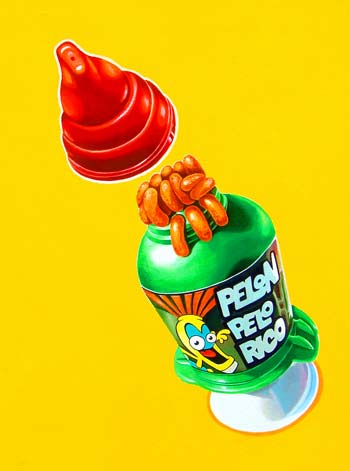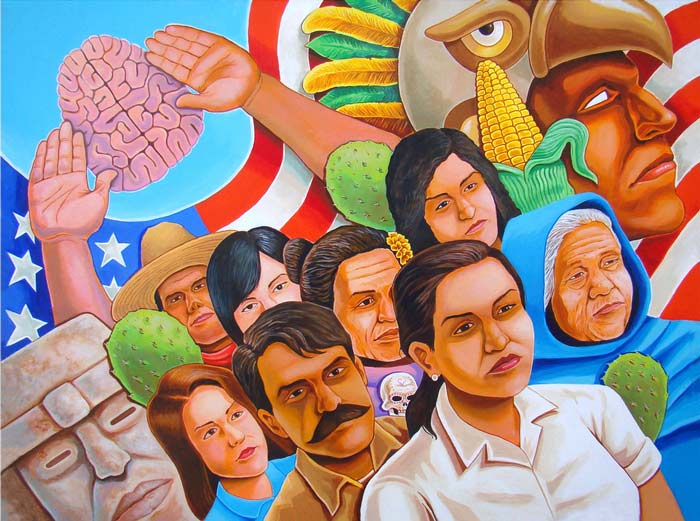I met Ricardo Gonzalez late in the afternoon inside the quaint and cozy Café Mestizo. Sitting down at a small table, I find him sketching into a small black notebook, expertly working his pen back and forth along the white pages. Drawing has been the 27-year-old painter’s hobby for as long as he can remember, and it’s now like second nature, as he uses his upbringing, his neighborhood and his Mexican culture as inspiration for his vibrant and bold acrylic paintings. During my time with this down-to-earth, talented artist, we speak of his paintings, the importance of art in communities and his experience in the Chicago art scene. موقع وليام هيل للمراهنات Check out the Q&A below.

Gozamos: Many of your paintings incorporate pre-Columbian concepts, as well as very bright and bold colors. Is this partly because of your Mexican background?
Ricardo Gonzalez: My artwork goes back to pre-Columbian [times] but I also try to incorporate contemporary elements and sometimes it’s just fusing the two. The majority of my work is stylized in the sense of old-fashioned muralists, so there’s a sense of surrealism but very recognizable imagery. You can tell when a person is a person but it’s just that they’re mashed in a more surreal way. I identify the bright colors with just the culture in general. It’s something that I think is not only just Mexican, but also all Latin American cultures tend to go back to those vibrant colors. I think that’s just the nature of the area. I incorporate a lot of vegetation and fruit in the majority of my paintings just to play out those bright, vibrant colors. At the same time it’s also thinking about the space these paintings will be displayed in and I think the actual wall will be a dark color or a light color with very little design going on, so the painting itself should be full of color, very vibrant and very eye-catching that will make the space more decorative.
What’s the process of creating one of your paintings? Do you allude to one specific theme or idea, or is it spontaneous?
RG: I usually have to research and think about what I have to paint. Most of the paintings that I do are for a specific purpose or I use them for a specific gallery or exhibit. With that in mind, I just sketch in my book and create ideas. Shortly after that it falls into place and I collect the reference material. But no I don’t really do spontaneous; if I do, it’s more just for fun. I do try to allude to an idea, theme or a sentiment, but I try not to give away too much because I feel it’s more interesting when the audience fills in the blank itself. I want them to have something to perhaps talk about and interpret. I try to make it so that the painting speaks for itself, if I’m not there for some reason.
You’re from the South Side neighborhood of Blue Island, but spend a lot of time in Pilsen. How has that influenced your paintings, if at all? ألعاب الروليت
RG: I think it just helped me appreciate artwork and creating artwork. A lot of the work that I did before visiting this area was very different. It lacked all of the culture. Prior to 2005, which is when I graduated from my undergrad at the American Academy of Art, and although it’s a fine school it was very traditional and [I was used to] working from a model. I had none of my culture in there.
It had no heart?
RG: Exactly. After [graduating] I decided I wanted to do something that meant something to me and to the people that I interact with or at least to some culture. A lot of that was just going back and learning a lot from my own culture and ethnicity and keeping in contact with family and friends and people in the area here, too. A lot of that came from being around here.
So, do you think you’ve learned more from being around other artists than from school?
RG: When you’re in school, you learn a lot, but there’s a lot of learning that I did outside afterward. I learned a lot for free once I was done, and that was from here being around friends, observing people working in progress, or just looking at books and just reading. I learned a lot from that. I learned a little more once I was out of school, but also I learned things when I was in school that I wouldn’t have learned elsewhere.
Do you think your work is political?
RG: Yeah, I have a few paintings that are political. It’s been something that only when the opportunity comes do I make the image for that. The reason for that is if you look at my work, to many people it seems not aggressive enough and it’s reflective of my own nature—more like standing back and examining without necessarily attacking directly at the very beginning. I just haven’t dabbled in anything overly political yet. That’s something I’m still learning and looking into. I totally respect the political work that artists do and I think it’s something that should exist in the arts community and I think it definitely does, especially with some of the murals around the area here.

How hard is it being an artist in Chicago?
RG: The sales aren’t what they used to be, and it’s also hard because although there’s a thriving arts community here in Chicago, it’s still small in comparison to all the other artists that exist. It’s funny, a friend of mine told me a lot of us artists here are great. If we came to L.A. we would make so much money. She explained to me that there are several generations of Latinos over there that have the income to actually purchase the artwork so there’s a lot of people there that work in white collar businesses because they have been in California for several generations versus Chicago. It’s hard in the sense that a lot of the artwork that I make is very Mexican and the ones that would appreciate it the most would probably be Mexican people, but people don’t always have the income, unfortunately, and that’s just reflective as to where we are in Chicago. It’s difficult.
You often teach art classes on the side. How important do you think learning through art is for a community?
RG: I think art is an important thing to teach because it’s something that if people aren’t showing to their children, where are they going to receive it and get the aspect of their culture? It’s also instructional things, too. You’re learning things from the past. Many of these [art] programs have been cut in schools so [kids] have to pick it up from somewhere, otherwise it becomes part of the culture that will become lost. Things get lost in translation. We emigrate from a homeland to a new one. I would want to preserve it as much as possible and I think a lot of artists think the same way.
You quit your 9-to-5 to sell your paintings full-time. Any regrets?
RG: It just drained me, working. It was nothing creative and it was a constant compromise just doing that because it was nothing of what I enjoyed doing. In the end it came to, Why am I here? This is not what I’m meant to do with my life. I miss how it paid the bills but other than that, there’s nothing else that I missed. ماهي لعبة البوكر I’m happier now for me. It’s only been difficult because I’ve had a traditional job since I was 16.

Gonzalez will be auctioning his most recent work, a painting titled DREAM for Reformation (below), at a fundraising auction for Francisco Mendoza at the National Museum of Mexican Art on Feb 27, 2011.
Make sure to check out more of Gonzalez’s work on his Flickr Page.